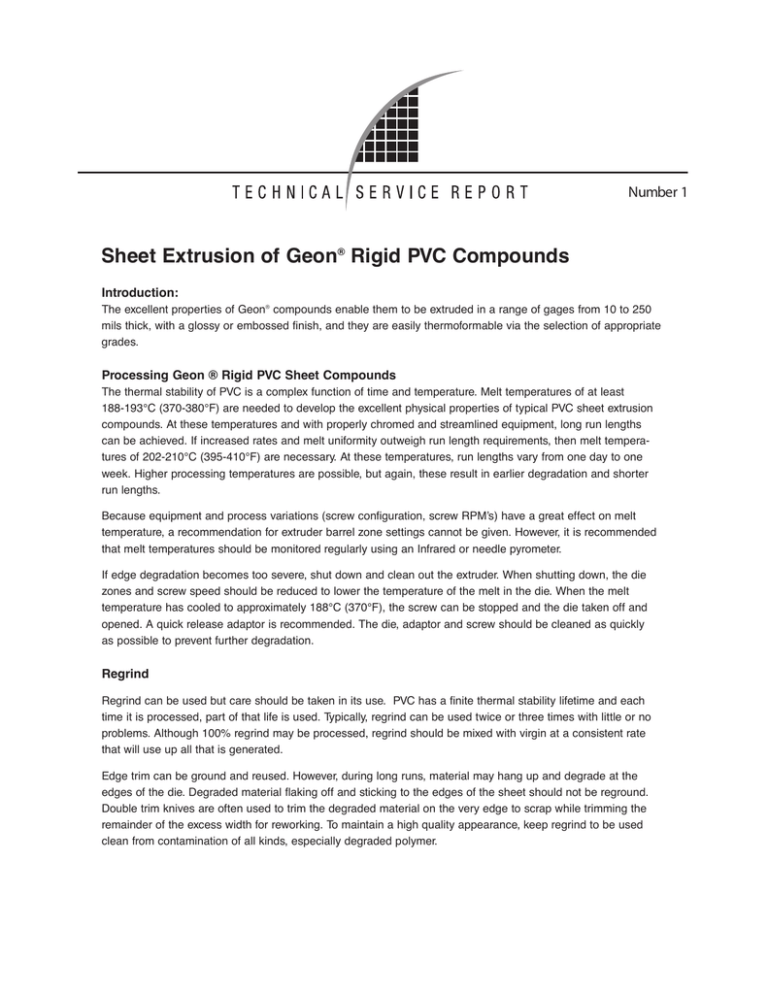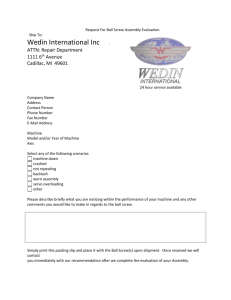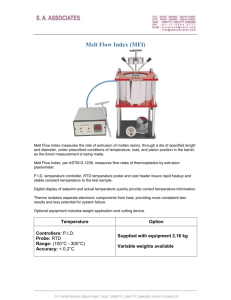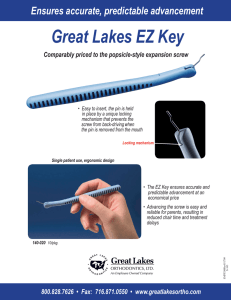
Number 1
Sheet Extrusion of Geon® Rigid PVC Compounds
Introduction:
The excellent properties of Geon® compounds enable them to be extruded in a range of gages from 10 to 250
mils thick, with a glossy or embossed finish, and they are easily thermoformable via the selection of appropriate
grades.
Processing Geon ® Rigid PVC Sheet Compounds
The thermal stability of PVC is a complex function of time and temperature. Melt temperatures of at least
188-193°C (370-380°F) are needed to develop the excellent physical properties of typical PVC sheet extrusion
compounds. At these temperatures and with properly chromed and streamlined equipment, long run lengths
can be achieved. If increased rates and melt uniformity outweigh run length requirements, then melt temperatures of 202-210°C (395-410°F) are necessary. At these temperatures, run lengths vary from one day to one
week. Higher processing temperatures are possible, but again, these result in earlier degradation and shorter
run lengths.
Because equipment and process variations (screw configuration, screw RPM’s) have a great effect on melt
temperature, a recommendation for extruder barrel zone settings cannot be given. However, it is recommended
that melt temperatures should be monitored regularly using an Infrared or needle pyrometer.
If edge degradation becomes too severe, shut down and clean out the extruder. When shutting down, the die
zones and screw speed should be reduced to lower the temperature of the melt in the die. When the melt
temperature has cooled to approximately 188°C (370°F), the screw can be stopped and the die taken off and
opened. A quick release adaptor is recommended. The die, adaptor and screw should be cleaned as quickly
as possible to prevent further degradation.
Regrind
Regrind can be used but care should be taken in its use. PVC has a finite thermal stability lifetime and each
time it is processed, part of that life is used. Typically, regrind can be used twice or three times with little or no
problems. Although 100% regrind may be processed, regrind should be mixed with virgin at a consistent rate
that will use up all that is generated.
Edge trim can be ground and reused. However, during long runs, material may hang up and degrade at the
edges of the die. Degraded material flaking off and sticking to the edges of the sheet should not be reground.
Double trim knives are often used to trim the degraded material on the very edge to scrap while trimming the
remainder of the excess width for reworking. To maintain a high quality appearance, keep regrind to be used
clean from contamination of all kinds, especially degraded polymer.
Extrusion Equipment
Single Screw Extruders
Single screw extruders have been the traditional workhorses of the sheet manufacturer because of their
versatility and relatively low initial cost. By changing conditions and, possibly, the screw and other accessory
equipment, the same machine can be used to process a variety of materials into a wide range of sheet
thicknesses.
Typically, cube or pelletized compound is used with single screw extruders for convenience. Powder compounds
are available for single screw machines but they require special handling and are more prone to air and moisture
entrapment in the melt.
One of two methods is typically used to address this issue. For pelletized or powder compounds, a two stage
screw can be used with either an open vent or an applied vacuum at the vent. A two stage screw and vent
combination must be carefully balanced for specific rates, dies and compounds.
A second technique used for powder extrusion is the vacuum hopper. This allows the use of single stage screws
with a special vacuum seal at the screw shank. A two hopper system is used to maintain a uniform vacuum on
the feed hopper. With either system, a crammer feed is recommended to assure uniform feed of the powder.
Special handling and housekeeping may also be required due to the dustier nature of powder compounds.
Powder compounds available for twin screw extruders will not give optimum performance on single screw
machines because of fundamental differences in the machines that dictate different compounding requirements.
The 4 1/2" extruder has been used almost exclusively for rigid PVC sheet extrusion although other sizes could
be used. Smaller machines may have difficulty filling a wide, thick die while maintaining the velocity and low
melt temperature which prevents early degradation in the die. Little developmental work has been done on larger
machines but nothing indicates that they could not be used. At recommended processing temperatures, rigid
PVC is typically higher in viscosity than many other materials. To prevent overloading the motor, a 150 to 250
horsepower motor for a 4 1/2" extruder is typically used. The gear ratio is also important to allow the motor to
run at its most efficient rate. Screw speed ranges of 40 to 80 RPM are typically used. This means a gear ratio
should be used to give a maximum speed of about 80 but not more than 100 RPM. Higher viscosities also
mean higher temperatures are reached by shear heating or friction. Thus, screw cooling and efficient barrel
cooling (i.e. water cooling), are critical to rigid PVC extrusion.
The recommended design for a general purpose, 4 1/2" rigid PVC sheet extrusion screw is given below:
L/D
24/1 to 32/1.
Compression Ratio
2.5
Metering Flights
14
Exit Depth
0.300
A single continuous flight with a square pitch is recommended. Four rows of mixing pins, discontinuous to the
flight, are recommended in the metering section to improve mixing. Many other types of mixing sections are
available and many have been evaluated with rigid PVC. Although most do improve mixing and melt uniformity,
they do so at the expense of increased melt temperature or shorter run lengths. Specific screw design recommendations are available from Technical Service personnel of PolyOne Corporation. Their recommendations
can serve as starting points for discussions with equipment manufacturers of your choice. Improved screw
designs, such as double flighted screws, can also offer improved performance such as a higher rate at the same
melt quality and temperature. The decision of whether the improved performance justifies the added cost is left
to the processor. An extruder length of 24 to 1 should be considered minimum while the longer 30 to 1 or 32 to 1
is desirable, especially if a vented barrel and two stage screw is used. A vented barrel, two stage screw and
vacuum is recommended for optimal surface appearance on sheet gage greater than 25 mils. Screw cooling
is mandatory for PVC sheet extrusion. The system should be set up so that the oil flows to the screw tip first so
as to cool the tip and thus prevent hang up and burning on the tip. The oil should then return between the
screw and the feed tube. The oil temperature should be controlled, with a recommended starting point of about
93-121°C (200-250°F).
Twin Screw Extruders
Twin screw extruders are better adapted to running powder compounds than cube compounds. The size of the
cubes limits heat conduction which is important in the twin screw process. The size and hardness of rigid PVC
cubes force the screws out against the barrel walls and cause higher barrel wear. Therefore, only powder
compounds designed for twin screw extrusion are recommended for twin screw machines. Twin screw extruders
offer several advantages over single screw extruders for high volume applications such as pipe and siding.
These same advantages would apply to sheet if the volumes justify the higher initial cost and higher maintenance costs. At high output rates, the twin screw extruder can deliver the same melt uniformity at a lower
melt temperature because of the lower shear rates in the screws. There is also a better balance between the
lubrication needs of the screw and the die. This can mean longer run lengths of thick, wide sheet. The deeper
channels of the twin screws are susceptible to backflow caused by pressure. Therefore, the amount of shear
heating increases and the rate falls faster with back pressure than with single screws. Versatility at running
different thicknesses is affected. The high pressure resulting from thin sheet extrusion can prohibit the use of
the twin screw.
The design of screws for twin screws is more complex than single screws and, therefore, little development
work has been done except by extruder manufacturers. Specific recommendations are therefore left to the
manufacturer.
Suggested start up conditions will vary with the type of machine, type of compound and sheet dimensions.
Typical running conditions vary for the two different types of twin screw extruders. Conical twins have higher
surface contact with the screw in the feed section. This means greater dependence on the screw oil temperature with lower barrel temperatures needed. Parallel twins will require higher feed zone temperatures, and
possibly, a decreasing profile. The property requirements of the sheet may dictate additives which affect the
processing of the compound. As an example, sheet for thermoformable applications requires excellent melt
strength which causes the compound to fuse faster than other compounds. Lower feed and possibly higher
exit barrel temperatures may be needed.
Die Design
Streamlining is extremely important in the design of adapters and dies for PVC. Any surfaces or edges that
cause the melt stream to change direction suddenly can be areas for hang up and potential degradation.
These must be avoided or corrected to maximize run length.
A manifold or coat hanger die is most often used. These dies are typically made with flexible lips that can be
adjusted to correct for minor flow imbalances. Often, a streamlined flexible bar is also included in the body of the
die to make larger adjustments in the flow. The flow channel should be chrome plated. Three thin applications of
chrome with polishing in between is recommended rather than one thick application. The chrome layer normally
has some porosity and triple plating minimizes this problem.
Keep the die in good repair. As the steel under the chrome is exposed, the iron will cause earlier degradation
and shorter run lengths. Defective heaters or thermocouples can cause flow imbalance and, possibly, early
degradation. Poor sealing surfaces allow material to leak which may then stagnate and degrade. The degraded
material can cause corrosion and further damage the die or can shorten run length by promoting earlier
degradation in the flow channel. Therefore, the die should be checked periodically for these and other
potential problems.
The purpose of the flow channel is to spread the material out to form a sheet of uniform thickness. The
dimensions of different sections of the channel will depend on the type of material, melt temperature, output rate,
die width, and desired sheet thickness. Generally, manufacturers build dies to accommodate the widest ranges
of these variables. However, increased versatility normally sacrifices efficiency at any one set of conditions. If a
die is to be used for one thickness range with one or a few similar compounds, it should be specifically designed
for that use.
Downstream
Three-roll polishing stacks are available from several machinery manufacturers. Embossing rolls constructed
from chromed steel, rubber or silicone may be used to impart a pattern onto the sheet. The traditional technique
has been to extrude “down the stack.” This involves extruding into the nip between the center and top roll,
following the center roll, then around the bottom roll and back up on cooling rollers. Recently, many companies
have gone to an "up the stack" technique for thick sheet. Contact with the center roll is usually the best and
when the melt is hottest, which means this surface generally has the best appearance. Going down the stack,
this surface is on the bottom and can easily be scratched or marred by the cooling rollers, cutting table or in
stacking. By going up the stack, this surface is upwards and not as susceptible to damage. Also, going up the
stack can result in less residual stresses in the sheet which is important in thermoforming. Going up the stack,
the sheet is allowed to come down the cooling train, being pulled uniformly by gravity. The puller can actually be
run slightly slower than the sheet speed to allow the sheet to shrink upon cooling and release internal stresses.
The extrudate is extruded into the nip between the two polishing rolls. It is desirable to get the die lips in as
close to the nip as possible. This prevents sagging between the die and nip which prevents early contact with
the lower roll and possible air entrapment at the surface or in the bank. Normally, a small bank of material is
maintained in the roll nip. This helps prevent slight surges or flow irregularities from causing a loss of polishing
or thickness. As a general rule, it is recommended the size of the bank should be kept to a minimum. Large
banks can cause bank marks in the sheet by the bank flopping over rather than rolling uniformly.
Quickly obtaining and maintaining uniform gauge of the sheet is very important. Therefore, many manufacturers
have developed sophisticated gauging equipment that goes in line and gives a constant read out of gauge. The
equipment controls the die to hold a uniform gauge by one of several different techniques. Although this equipment is certainly desirable, the very high initial cost must be justified. A hand held micrometer is a low cost, yet
accurate method of determining gauge. However, it is very slow since the sheet must go all the way down the
train and be cut off to determine the gauge across the sheet.
There are several techniques to help zero in on the correct gauge quickly. Unlike calenders, the rolls of a sheet
stack have very little effect on the uniformity of gauge across the sheet. The gauge uniformity must be controlled
by adjusting the flow from the die. The gap between the roll and low gauge areas of the sheet can sometimes be
observed directly. Low gauge areas also cause poor embossing or polishing which may appear as areas of
lower gloss on the sheet. These gauge bands should be uniform in width and run parallel to the sheet width.
These can be eliminated by opening the appropriate die lip or choker bolts. If the width of the bands is varying
significantly or if “lakes” of low gloss, unpolished areas are apparent, then the flow from the die is surging and
extruder conditions should be adjusted. Occasionally, a mist will appear in bands on the contact roll (top roll for
down the stack). This indicates that the compound is not touching the contact roll and is, therefore, a low gauge
area. The bank is also a good indication of the gauge uniformity. Excessive buildup in the bank indicates too
much flow and probably heavy gauge. Lack of a bank indicates too little flow and thin gauge. The desirable
situation is a small uniform bank across the entire width. The bank should be run out after each major die
adjustment. If not, the material in the bank can hide the effects of the adjustment and make it appear as if a
second adjustment is needed.
A small bank can be eliminated by simply opening the contact roll. A larger bank should be run out by
increasing the roll speeds. The extruder speed should not be changed to adjust the size of the bank. Screw
speed affects the melt quality and temperature. These factors can change the flow in the die and, therefore,
necessitate rebalancing the die.
The roll temperature must be balanced between obtaining the fastest cooling, best surface and maintaining flat
sheet. Significant differences between roll temperatures can cause warping or curling in thin sheet and residual
stresses in thick sheet. Generally, roll temperatures between 49-93°C (120-200° F) are used.
Accessory Equipment
Screen packs are recommended for the extrusion of rigid PVC. They are used to screen out contamination that
might stick In the die lips or cause surface imperfections or gels. They also increase back pressure, which
improves mixing of the melt. For this reason, the output rate can often be increased while maintaining the
needed melt uniformity.
The screen to be used depends on the equipment and sheet requirements. Typically, a 20 and 40 mesh or a 20,
40 and 60 mesh pack is used. Adding more screens, or using screens with finer mesh, increases the back
pressure. This improves the melt uniformity and, therefore, the quality of the sheet. However, higher back
pressures cause higher melt temperatures which can mean shorter run lengths. Finer mesh screens collect
more contamination which means shorter times between needed changes of plugged screens. For thick gauge
sheet, at least one screen with openings smaller than the die lip opening should be used. This will catch
potential hard contamination that would stick in the lips causing damage to the die lips or die lines in the sheet.
Stainless steel screens are highly recommended to avoid chemical reactions and potential PVC degradation.
The breaker plate used with the screens should also be stainless steel. Holes should be chamfered on both
sides for streamlining areas of possible hang-up. Holes should be sized and spaced for maximum open area
with 1/8" to 3/16" being typical.
Automatic screen changes are normally not recommended for use with PVC. Even those units which the
manufacturer claims can be used for PVC often contain areas where PVC can stagnate and eventually degrade.
Sluff-off of degraded PVC can then stick in the die or appear in the surface of the sheet. For these reasons,
even the best contemporary automatic screen changes can shorten run lengths.
Static mixers and melt pumps are normally not recommended for use with PVC. They do offer the advantage of
improving the melt uniformity. They improve mixing of colorants and other ingredients. They also blend materials
with temperature variations, which improves gage control and surface appearance. This can allow higher output
rates if melt uniformity us currently limiting the rate. However, static mixers increase back pressure with a
resulting increase in melt temperature.
Both static mixers and melt pumps increase metal contact area and provide opportunities for stagnation, causing
short run lengths. If a mixer or melt pump is used it should be stainless steel or chrome plated, have minimal
areas of possible stagnation and be easily cleanable.
As always, the advantages offered by accessory equipment must be weighed against any possible reduction
in run length.
Unlike some other materials, most rigid PVC compounds do not have to be dried before extrusion. However, the
use of dryers on the feed hopper with air temperature of 150 –160 °F have been found to improve the surface
appearance of sheet thicker than 50 mils and also offers the potential of increasing extruder output.
QUALITY CONTROL TESTS FOR RIGID SHEET
DIMENSIONAL CONTROL
Uniform sheet thickness is an important property. This is normally determined by measuring the thickness at
various intervals across the width of the sheet. An alternate method is to weigh various areas of the sheet;
i.e. one square foot. For thin gage extrusion, automatic gage measurement/control systems are available.
COLOR and GLOSS
Color can be judge visually using a controlled light source and a properly maintained reference standard. In
visual comparison, the surface gloss does affect the apparent color. High gloss surfaces tend to appear darker
and more saturated. Preferably, an instrument such as a spectrophotomer is used for quantitative assessment.
Gloss meters are available to measure gloss. The result depends upon the angle at which the measure is
conducted. Sixty degree gloss is the most prevalent. Additional angles are employed for specific applications.
SURFACE APPEARANCE
This is usually a visual appraisal for pinholes, waviness, die lines, orange peel, chatter marks, contamination,
pics, gels, chipping, burning, etc.
THERMOFORMING
Either small or full scale thermoforming can be used to evaluate the extruded rigid PVC sheet. Not only will this
identify residual stresses, but it serves the purpose of evaluating melt flow.
Based upon the results of testing using small-scale laboratory-type equipment, the foregoing information may not provide a reliable indication
of performance or properties obtained or obtainable on larger-scale equipment. PolyOne makes no representations, guarantees or warranties of
any kind respecting the accuracy of the foregoing information or the results obtained or obtainable through the use of the foregoing
information. POLYONE MAKES NO WARRANTIES, EXPRESS OR IMPLIED, INCLUDING, BUT NOT LIMITED TO, IMPLIED
WARRANTIES OF MERCHANTABILITY AND FITNESS FOR A PARTICULAR PURPOSE, either with respect to the foregoing information or PolyOne’s products. The customer has all responsibility for testing and determining the suitability of PolyOne’s products for use in
customer’s application. PolyOne Corporation shall have no liability for, and the customer assumes all risk and liability of, any use customer
makes of the foregoing information and/or the products purchased from PolyOne. Nothing herein shall operate as permission, recommendation
or inducement to practice any patented invention without permission of the patent owner.
PolyOne Corporation
33587 Walker Road
Avon Lake, OH 44012
1.866.POLYONE (1.866.765.9663)
www.PolyOne.com
At PolyOne, we deliver premiumquality products and services, which
our customers use to enhance their
own products. We believe no competitor can match our technical
expertise because no workforce can
outperform the people of PolyOne.
Our people are ONE team working
together – our strength and our pride.
Their skills, passion and dedication
are shaping a potent industry leader,
a concerned corporate citizen and a
great place to work.
© 2005, PolyOne Corporation
All Rights Reserved
Update: 05.2005



